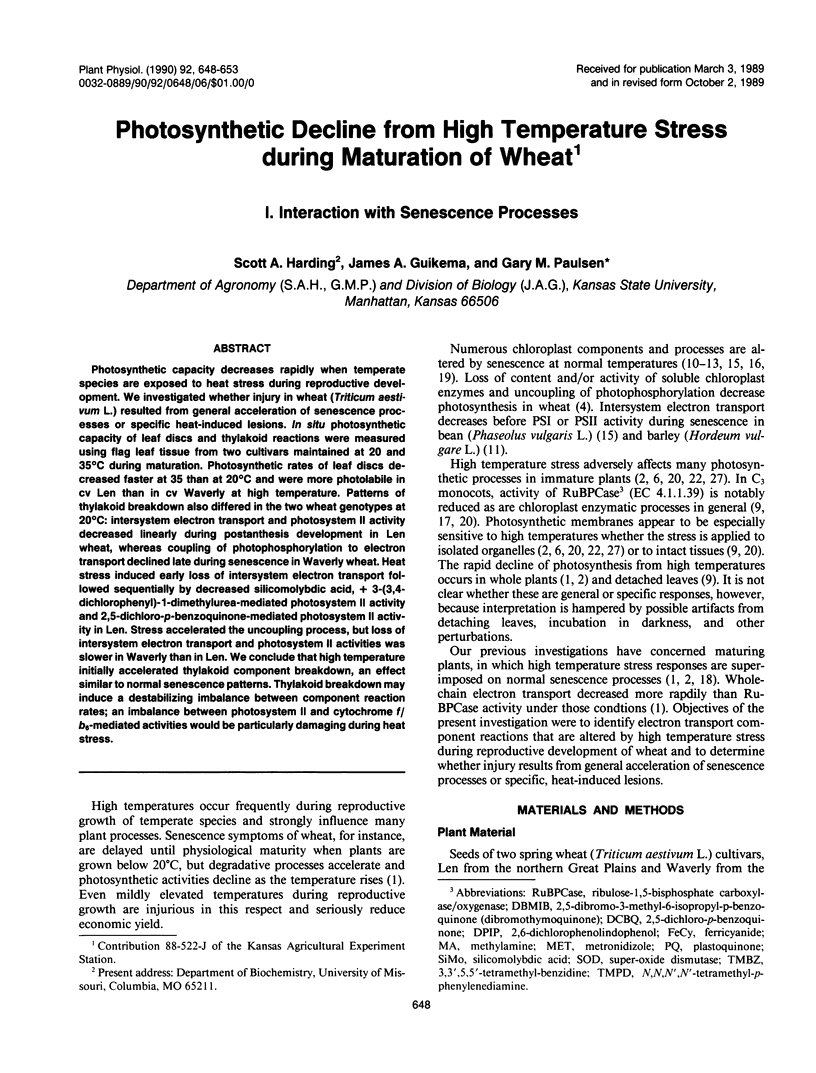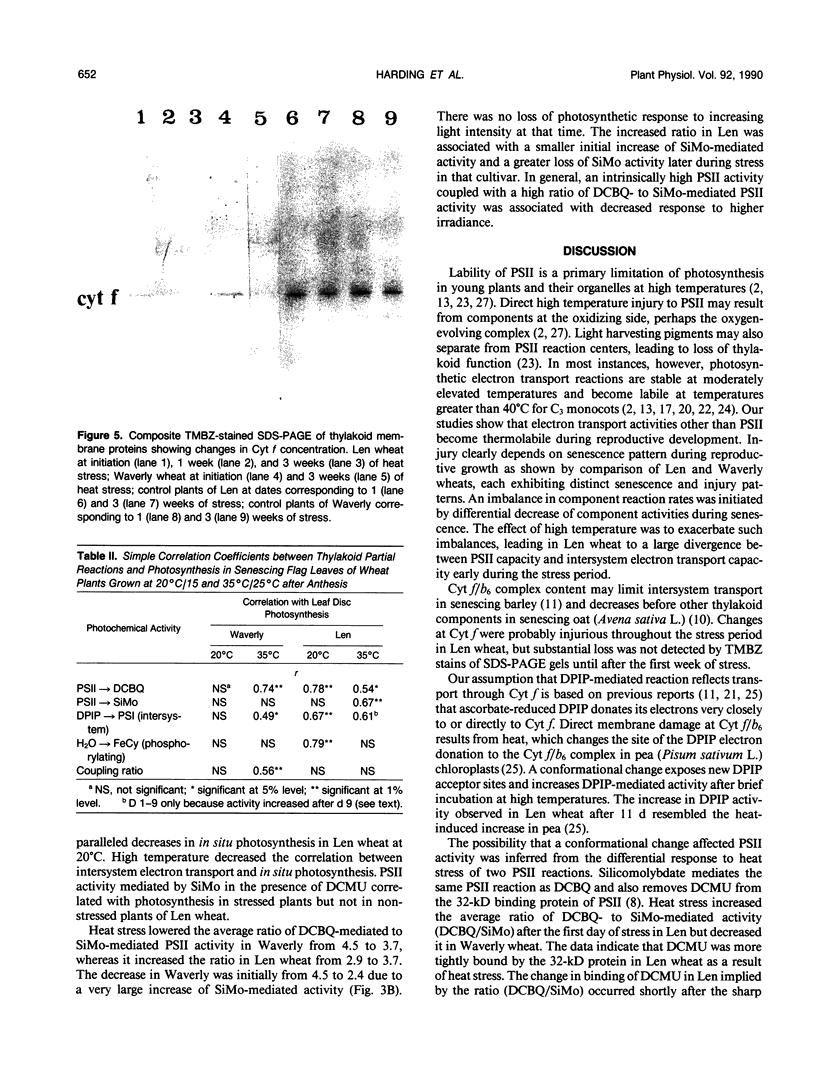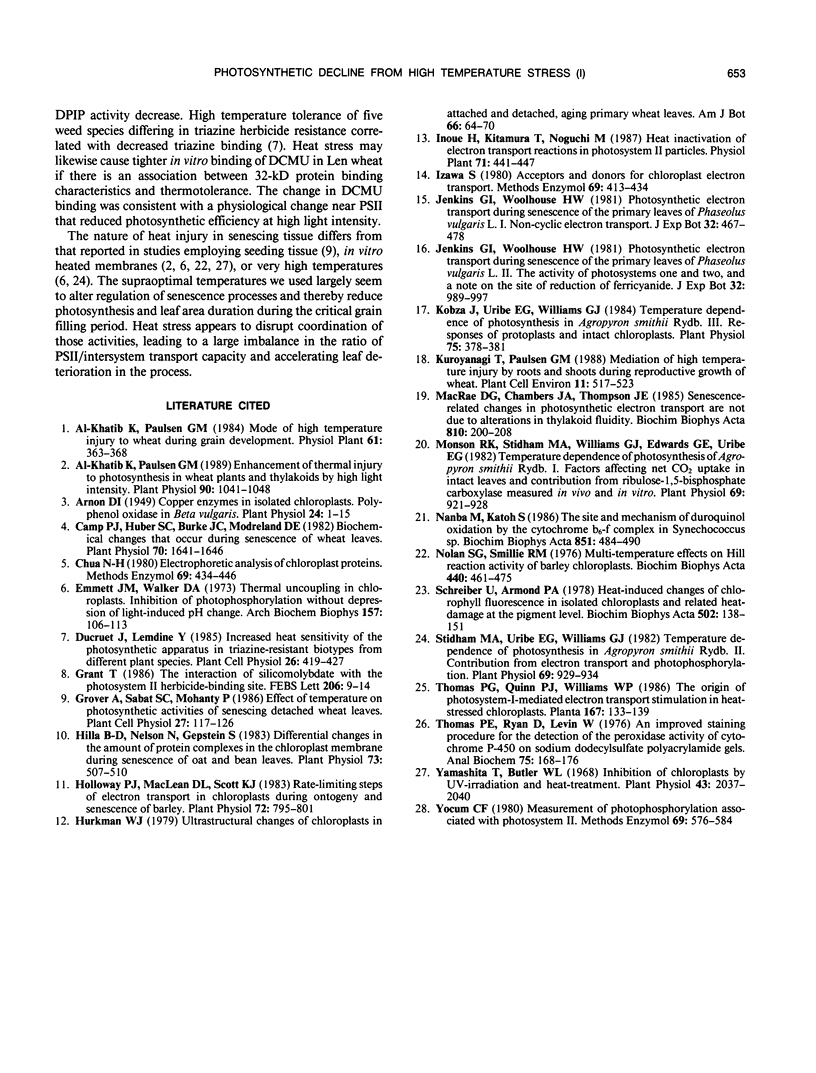Abstract
Photosynthetic capacity decreases rapidly when temperate species are exposed to heat stress during reproductive development. We investigated whether injury in wheat (Triticum aestivum L.) resulted from general acceleration of senescence processes or specific heat-induced lesions. In situ photosynthetic capacity of leaf discs and thylakoid reactions were measured using flag leaf tissue from two cultivars maintained at 20 and 35°C during maturation. Photosynthetic rates of leaf discs decreased faster at 35 than at 20°C and were more photolabile in cv Len than in cv Waverly at high temperature. Patterns of thylakoid breakdown also differed in the two wheat genotypes at 20°C: intersystem electron transport and photosystem II activity decreased linearly during postanthesis development in Len wheat, whereas coupling of photophosphorylation to electron transport declined late during senescence in Waverly wheat. Heat stress induced early loss of intersystem electron transport followed sequentially by decreased silicomolybdic acid, + 3-(3,4-dichlorophenyl)-1-dimethylurea-mediated photosystem II activity and 2,5-dichloro-p-benzoquinone-mediated photosystem II activity in Len. Stress accelerated the uncoupling process, but loss of intersystem electron transport and photosystem II activities was slower in Waverly than in Len. We conclude that high temperature initially accelerated thylakoid component breakdown, an effect similar to normal senescence patterns. Thylakoid breakdown may induce a destabilizing imbalance between component reaction rates; an imbalance between photosystem II and cytochrome f/b6-mediated activities would be particularly damaging during heat stress.
Full text
PDF





Images in this article
Selected References
These references are in PubMed. This may not be the complete list of references from this article.
- Al-Khatib K., Paulsen G. M. Enhancement of thermal injury to photosynthesis in wheat plants and thylakoids by high light intensity. Plant Physiol. 1989 Jul;90(3):1041–1048. doi: 10.1104/pp.90.3.1041. [DOI] [PMC free article] [PubMed] [Google Scholar]
- Arnon D. I. COPPER ENZYMES IN ISOLATED CHLOROPLASTS. POLYPHENOLOXIDASE IN BETA VULGARIS. Plant Physiol. 1949 Jan;24(1):1–15. doi: 10.1104/pp.24.1.1. [DOI] [PMC free article] [PubMed] [Google Scholar]
- Ben-David H., Nelson N., Gepstein S. Differential Changes in the Amount of Protein Complexes in the Chloroplast Membrane during Senescence of Oat and Bean Leaves. Plant Physiol. 1983 Oct;73(2):507–510. doi: 10.1104/pp.73.2.507. [DOI] [PMC free article] [PubMed] [Google Scholar]
- Camp P. J., Huber S. C., Burke J. J., Moreland D. E. Biochemical Changes that Occur during Senescence of Wheat Leaves : I. Basis for the Reduction of Photosynthesis. Plant Physiol. 1982 Dec;70(6):1641–1646. doi: 10.1104/pp.70.6.1641. [DOI] [PMC free article] [PubMed] [Google Scholar]
- Emmett J. M., Walker D. A. Thermal uncoupling in chloroplasts. Inhibition of photophosphorylation without depression of light-induced pH change. Arch Biochem Biophys. 1973 Jul;157(1):106–113. doi: 10.1016/0003-9861(73)90395-0. [DOI] [PubMed] [Google Scholar]
- Holloway P. J., Maclean D. J., Scott K. J. Rate-Limiting Steps of Electron Transport in Chloroplasts during Ontogeny and Senescence of Barley. Plant Physiol. 1983 Jul;72(3):795–801. doi: 10.1104/pp.72.3.795. [DOI] [PMC free article] [PubMed] [Google Scholar]
- Kobza J., Uribe E. G., Williams G. J. Temperature Dependence of Photosynthesis in Agropyron smithii Rydb. : III. Responses of Protoplasts and Intact Chloroplasts. Plant Physiol. 1984 Jun;75(2):378–381. doi: 10.1104/pp.75.2.378. [DOI] [PMC free article] [PubMed] [Google Scholar]
- Monson R. K., Stidham M. A., Williams G. J., Edwards G. E., Uribe E. G. Temperature Dependence of Photosynthesis in Agropyron smithii Rydb. : I. FACTORS AFFECTING NET CO(2) UPTAKE IN INTACT LEAVES AND CONTRIBUTION FROM RIBULOSE-1,5-BISPHOSPHATE CARBOXYLASE MEASURED IN VIVO AND IN VITRO. Plant Physiol. 1982 Apr;69(4):921–928. doi: 10.1104/pp.69.4.921. [DOI] [PMC free article] [PubMed] [Google Scholar]
- Nolan W. G., Smillie R. M. Multi-temperature effects on Hill reaction activity of barley chloroplasts. Biochim Biophys Acta. 1976 Sep 13;440(3):461–475. doi: 10.1016/0005-2728(76)90034-7. [DOI] [PubMed] [Google Scholar]
- Schreiber U., Armond P. A. Heat-induced changes of chlorophyll fluorescence in isolated chloroplasts and related heat-damage at the pigment level. Biochim Biophys Acta. 1978 Apr 11;502(1):138–151. doi: 10.1016/0005-2728(78)90138-x. [DOI] [PubMed] [Google Scholar]
- Stidham M. A., Uribe E. G., Williams G. J. Temperature Dependence of Photosynthesis in Agropyron smithii Rydb. : II. CONTRIBUTION FROM ELECTRON TRANSPORT AND PHOTOPHOSPHORYLATION. Plant Physiol. 1982 Apr;69(4):929–934. doi: 10.1104/pp.69.4.929. [DOI] [PMC free article] [PubMed] [Google Scholar]
- Thomas P. E., Ryan D., Levin W. An improved staining procedure for the detection of the peroxidase activity of cytochrome P-450 on sodium dodecyl sulfate polyacrylamide gels. Anal Biochem. 1976 Sep;75(1):168–176. doi: 10.1016/0003-2697(76)90067-1. [DOI] [PubMed] [Google Scholar]
- Yamashita T., Butler W. L. Inhibition of chloroplasts by UV-irradiation and heat-treatment. Plant Physiol. 1968 Dec;43(12):2037–2040. doi: 10.1104/pp.43.12.2037. [DOI] [PMC free article] [PubMed] [Google Scholar]



